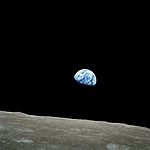Apollo 8
Apollo 8 (launched December 21, 1968) was the first human spaceflight mission to escape from the gravitational field of planet Earth; the first to be captured by and escape from the gravitational field of another celestial body; and the first crewed voyage to return to planet Earth from another celestial body - Earth's Moon. The three-man crew of Mission Commander Frank Borman, Command Module Pilot James Lovell, and Lunar Module Pilot William Anders became the first humans to see the far side of the Moon with their own eyes, as well as the first humans to see planet Earth from beyond low Earth orbit. The mission was accomplished with the first manned launch of a Saturn V rocket. Apollo 8 was the second manned mission of the Apollo Program.[1]
Originally planned as a low Earth orbit Lunar Module/Command Module test, the mission profile was changed to the more ambitious lunar orbital flight in August 1968 when the Lunar Module scheduled for the flight became delayed. The new mission's profile, procedures and personnel requirements left an uncharacteristically short time frame for training and preparation, thus placing more demands than usual on the time, talent, and discipline of the crew.[1]
After launching on December 21, 1968, the crew took three days to travel to the Moon. They orbited ten times over the course of 20 hours, during which the crew made a Christmas Eve television broadcast in which they read the first 10 verses from the Book of Genesis. At the time, the broadcast was the most watched TV program ever. Apollo 8's successful mission paved the way for Apollo 11 to fulfill U.S. President John F. Kennedy's goal of landing a man on the Moon before the end of the decade.[1]
Genesis reading
On December 24, 1968, in what was the most watched television broadcast at the time[2][3], the crew of Apollo 8 read in turn from the Book of Genesis as they orbited the moon. William Anders, Jim Lovell, and Frank Borman recited verses 1 through 10, using the King James Version text.[4]
Transcript
- William Anders
- "We are now approaching lunar sunrise and, for all the people back on Earth, the crew of Apollo 8 has a message that we would like to send to you.
In the beginning God created the heaven and the earth.
And the earth was without form, and void; and darkness was upon the face of the deep.
And the Spirit of God moved upon the face of the waters. And God said, Let there be light: and there was light.
And God saw the light, that it was good: and God divided the light from the darkness.
- Jim Lovell
- "And God called the light Day, and the darkness he called Night. And the evening and the morning were the first day.
And God said, Let there be a firmament in the midst of the waters, and let it divide the waters from the waters.
And God made the firmament, and divided the waters which were under the firmament from the waters which were above the firmament: and it was so.
And God called the firmament Heaven. And the evening and the morning were the second day.
- Frank Borman
- "And God said, Let the waters under the heavens be gathered together unto one place, and let the dry land appear: and it was so.
And God called the dry land Earth; and the gathering together of the waters called he Seas: and God saw that it was good.
And from the crew of Apollo 8, we close with good night, good luck, a Merry Christmas - and God bless all of you, all of you on the good Earth."
Lawsuit
Madalyn Murray O'Hair, an atheist, responded by suing the United States government, alleging violations of the First Amendment.[5] The suit was dismissed by the Supreme Court due to lack of jurisdiction.[6] Later on the Apollo 11 mission, Buzz Aldrin received communion on the lunar surface shortly after landing. He kept his actions secret for many years.[5]
References
- ↑ 1.0 1.1 1.2 Apollo 8 by Wikipedia
- ↑ Race to the Moon - Telecasts from Apollo 8 by PBS, September 22, 2005
- ↑ The National Archives Features Special Christmas Eve Message from APOLLO 8 by U.S. National Archives, December 7, 2006
- ↑ The Apollo 8 Christmas Eve Broadcast by NASA National Space Science Data Center, September 25, 2007
- ↑ 5.0 5.1 Chaikin, Andrew. "A Man On The Moon: The Voyages of the Apollo Astronauts". pp 204,623. Viking (1994)
- ↑ O'Hair v. Paine, 397 U.S. 531 by Findlaw. 1970


